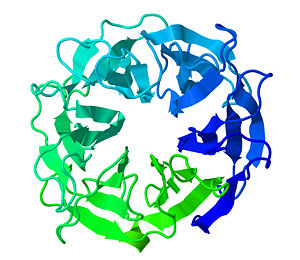Exo-α-1,5-L-Arabinanase (Arb93A) (EC 3.2.1.55) is an enzyme from the GH93 family encoded by the gene fg03054.1. The CAZY data base describes the enzymes of this family as α-1,5-L-arabinanases which are essential glycoside hydrolases participating in the complete hydrolysis of α-1,5-L-arabinofuranosic linkages in hemicellulose. This is important since hemicellulose is a major compound in plant biomass that is used in many industrial processes such as bioethanol or pharmaceutical production. Thus the potential practical application of those enzymes in various industrial processes gives them a great interest in the industry domain.
Specificity and hydrolysis activity
Arb93A has an activity of 1065U/mg. It has a large domain of pH and temperature for which it keeps more than 80% of its activity: from pH 4-6 and temperature 30-50°C. Its optimum activity is reached at pH 5 and 40°C.
Concerning the specificity of this enzyme, it has been found by comparing the differences in activities for different substrates with variable sizes. The enzyme was found to be active with a molecule of at least 4 sugars. The differences found could be explained by the fact that Arb93A hydrolyses only linear α-1,5-L-arabinan and cleaves linear α-1,5-arabinan from the non-reducing end into α-1,5-arabinobiose.
The digestion of arabinan produces only arabinose and arabinobiose, which shows that Arb93A degrades arabinan in an exo-type of action.
Sequence and structure
The coding sequence isolated from RNA for Arb93A has a length of 1,146 base pairs, which matches 381 amino acids. A cleavage occurs between Ala16 and Lys17 during the maturation. The native enzyme is therefore a 366 amino acids long monomeric protein for a molecular weight of 41,077 Da (theoretical value; experimental value ~ 40,000 Da).
Arb93A presents six blades forming a propeller, each of the blades composed by four antiparallel β sheets. The first β-strand is included in the last blade and closes the β-propeller by forming the molecular Velcro, a structure that is classically observed for this type of fold. Arb93A also presents two Asp β-hairpin boxes in the first and second blades that might have a role in maintaining the integrity of the β-propeller.
Concerning the extremities of the amino acids sequence, several residues at the N and C termini are outside of the β-propeller and there is a small α-helix at the C terminus.
Enzymatic functioning of exo-α-1,5-L-arabinanase
The active site is located in a deep acidic L-shaped crevice in the centre of the β-propeller. The contacts between the sugar and Arb93A are shown
A movement of about 1Å is observed for some loops close to the active site to accommodate the sugar.
(image)
Arb93A acts through a classical retaining mechanism which involves two carboxylate residues, Glu170 which acts as a nucleophile and Glu242 which acts as an acid/base. Tyr337 also has a particular role: when muted to alanine, it reduces the activity of 93%. This indicates that it has an important role but not critical. This residue could have a role of stabilisation of the substrate in the binding pocket or it may facilitate the nucleophile attack.

